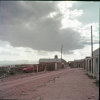medicine bundle
People of various Native American tribes often carry with them a small pouch, usually made of deer skin, which contains a few items that have totemic, spiritual, and ceremonial value. This bundle is believed to provide protection and healing, and is carried under the person’s clothes, either on a string around the neck or under the waist belt. It may contain small, natural objects such as special rocks, animal parts, or carved amulets, and usually also includes sacred pollen, which is commonly used in a variety of prayers and rituals. The Navajo word for medicine pouch is jish, which applies to both the small bag and its contents.









